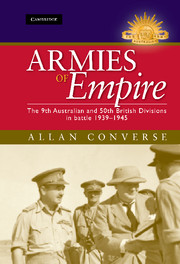3 - Baptisms of fire: 1940–41
Published online by Cambridge University Press: 05 August 2013
Summary
The 50th Division mobilised on 2 September 1939, under the command of Major-General G. Le Q. Martel. The 50th's second-line duplicate, the 23rd (Northumbrian) Division, split off from the 50th on 2 October. The 50th trained in England for several months, and began crossing to France to join the British Expeditionary Force (BEF) in January 1940. The 23rd also went to France late in April for labour duties, although it was barely trained and had no guns or other heavy equipment. The 50th received a new third brigade, the 25th, in May.
Unlike the 50th, the 9th Division was not created at a stroke, but evolved over more than a year before assuming something like its final form. The first elements of the 9th (18th Infantry Brigade and other troops) began to organise as part of the 6th Division soon after Australia declared war. The 18th Brigade and supporting elements were detached from the 6th Division and sent to Britain in July 1940, where they formed the nucleus of Australforce (Major-General H.D. Wynter). To strengthen Australforce, a new infantry brigade (the 25th, which included the 2/32nd Battalion) was later organised from reinforcement drafts and surplus personnel of existing Australian units in the force. The Australian Government also decided to raise two additional AIF divisions, the 7th (20th, 21st and 26th Brigades) and the 8th (22nd, 23rd and 24th Brigades), and these divisions began forming in Australia in the spring of 1940. It was finally decided to concentrate most of the AIF in the Middle East and to raise Australforce to divisional strength. The 7th Division arrived in the Middle East at the end of 1940, together with the 24th Brigade, which had been taken from the 8th Division. Australforce had been designated 9th Australian Division on 23 October, and it arrived in the Middle East from Britain at about the same time. In January 1941 a major reorganisation took place. The 9th Division received the new 24th Brigade and traded away its historic 18th and 25th Brigades to the 7th Division in exchange for the 20th and 26th. Wynter's health failed, and on 2 February Morshead took command. Finally, the 18th Brigade was detached from the 7th Division and sent back to the 9th in April, just in time for the siege of Tobruk.
- Type
- Chapter
- Information
- Armies of EmpireThe 9th Australian and 50th British Divisions in Battle 1939–1945, pp. 56 - 100Publisher: Cambridge University PressPrint publication year: 2011



